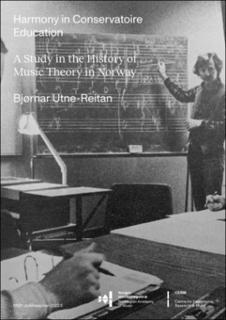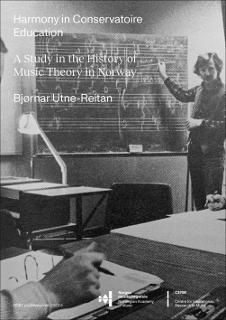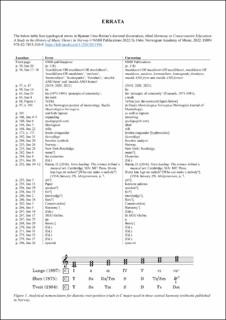| dc.contributor.author | Utne-Reitan, Bjørnar | |
| dc.date.accessioned | 2022-11-15T15:29:31Z | |
| dc.date.available | 2022-11-15T15:29:31Z | |
| dc.date.issued | 2022 | |
| dc.identifier.isbn | 978-82-7853-310-9 (trykt) | |
| dc.identifier.isbn | 978-82-7853-311-6 (pdf) | |
| dc.identifier.issn | 0333-3760 | |
| dc.identifier.issn | 2535-373X (online) | |
| dc.identifier.uri | https://hdl.handle.net/11250/3031991 | |
| dc.description | Dissertation for the PhD degree Norwegian Academy of Music, Oslo 2022 - Avhandling (Ph.D.) - Norges musikkhøgskole, Oslo 2022 | en_US |
| dc.description.abstract | Abstract -
The point of departure for this dissertation is one of the most fundamental questions in music theory education: Why do music performance students need to study music-theoretical disciplines such as harmony and counterpoint? The dissertation addresses this question through a historical study of music theory education in Norway in general, and Oslo in particular, and concentrates on the role of these disciplines in the mandatory portion of the conservatoire training of professional musicians in the tradition of Western classical music. The focus is on the Oslo Conservatoire, which opened in 1883 and became the Norwegian Academy of Music in 1973, but this case is also related to wider national and international contexts. More broadly, the dissertation investigates how the music theory discourse in Norway has been constructed and transformed from the late 19th century to the early 21st century.
The aim of the study is to develop a wide-ranging historical understanding of how music-theoretical disciplines such as harmony and counterpoint have been constructed and justified as part of higher music education. This understanding can challenge and inform current practices, as well as future developments, in conservatoire music theory. Theoretically, it is inspired by Michel Foucault’s studies of historical discourse. The source material encompasses a wide range of historical documents, primarily formal curricula, textbooks and periodicals.
After presenting a survey and close readings of the source material, the dissertation discusses how the construction of the music theory discourse in Norway transformed during the long 20th century. It is argued that several important ruptures and transformations occurred c. 1945–1975. What until then had almost exclusively been a craft-oriented discourse was transformed into a broader discourse that constructed music theory as, among other things, being about ‘understanding music’. Connected to this, Roman numerals were replaced by function symbols in harmonic analysis and the theory training was renamed satslære. The dissertation highlights the complexity of these changes, showing how the idea of theory as craft, coupled with an aversion to theoretical complexity, nonetheless remained strong throughout the 20th century and into the 21st century.
Keywords: History of music theory; Music theory in Norway; Higher music education; Discourse of music theory; Music theory pedagogy; Music theory education; Satslære; Harmony and counterpoint. | en_US |
| dc.description.abstract | Sammendrag -
Utgangspunktet for denne avhandlingen er et av de mest grunnleggende spørsmålene innen musikkteoriutdanning: Hvorfor må utøvende musikkstudenter studere musikkteoretiske disipliner som harmonilære og kontrapunkt? Avhandlingen utforsker dette gjennom en historisk studie av musikkteoriutdanning i Norge generelt og Oslo spesielt, og ser på disse musikkteoretiske fagenes rolle i den obligatoriske delen av utdanningen av profesjonelle musikere innen vestlig klassisk musikk ved konservatorier. Studien fokuserer på Musikkonservatoriet i Oslo som åpnet i 1883 og ble omgjort til Norges musikkhøgskole i 1973, men denne case-en sees også i lys av større nasjonale og internasjonale kontekster. I bredere forstand undersøker avhandlingen hvordan musikkteoridiskursen i Norge har blitt konstruert og transformert fra slutten av 1800-tallet til begynnelsen av 2000-tallet.
Målet med studien er å utvikle en bred, historisk forståelse av hvordan musikkteoretiske disipliner som harmonilære og kontrapunkt har blitt konstruert og legitimert som del av høyere musikkutdanning. Denne kan utfordre og informere nåværende praksis, og fremtidig utvikling, i musikkteori på konservatorienivå. Teoretisk er arbeidet inspirert av Michel Foucaults studier av historisk diskurs. Kildematerialet omfatter et bredt spekter av historiske dokumenter, først og fremst formelle læreplaner, lærebøker og tidsskrifter.
Etter å ha presentert en oversikt over, og nærlesninger av, kildematerialet, diskuteres det hvordan konstruksjonen av musikkteoridiskursen i Norge endret seg i løpet av det utvidede 1900-tallet. Det argumenteres for at flere viktige brudd og transformasjoner skjedde i perioden ca. 1945–1975. Det som før nesten utelukkende hadde vært en håndverksorientert diskurs, ble transformert til en bredere diskurs som konstruerer musikkteori som noe som blant annet handler om å «forstå musikk». I sammenheng med dette ble trinn erstattet av funksjoner i harmonisk analyse og teoriopplæringen omdøpt til satslære. Studien fremhever kompleksiteten i disse endringene ved å vise hvordan ideen om teori som håndverksfag, kombinert med en aversjon mot teoretisk kompleksitet, forble sterk gjennom hele 1900-tallet og inn på 2000-tallet.
Stikkord: Musikkteorihistorie; Musikkteori i Norge; Høyere musikkutdanning; Musikkteoridiskursen; Musikkteoripedagogikk; Musikkteoriutdanning; Satslære; Harmonilære og kontrapunkt. | en_US |
| dc.language.iso | eng | en_US |
| dc.publisher | Norges musikkhøgskole | en_US |
| dc.relation.ispartofseries | NMH-publikasjoner;2022:5 | |
| dc.subject | history of music theory | en_US |
| dc.subject | music theory in Norway | en_US |
| dc.subject | higher music education | en_US |
| dc.subject | discourse of music theory | en_US |
| dc.subject | music theory pedagogy | en_US |
| dc.subject | music theory education | en_US |
| dc.subject | satslære | en_US |
| dc.subject | harmony and counterpoint | en_US |
| dc.subject | musikkteorihistorie | en_US |
| dc.subject | musikkteori i Norge | en_US |
| dc.subject | høyere musikkutdanning | en_US |
| dc.subject | musikkteoridiskursen | en_US |
| dc.subject | musikkteoripedagogikk | en_US |
| dc.subject | musikkteoriutdanning | en_US |
| dc.subject | satslære | en_US |
| dc.subject | harmonilære og kontrapunkt | en_US |
| dc.title | Harmony in conservatoire education. A study in the history of music theory in Norway | en_US |
| dc.type | Doctoral thesis | en_US |
| dc.description.version | publishedVersion | en_US |
| dc.subject.nsi | VDP::Humaniora: 000::Musikkvitenskap: 110 | en_US |
| dc.source.pagenumber | xiii, 306 s. | en_US |


